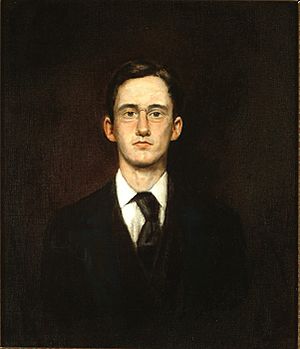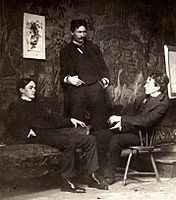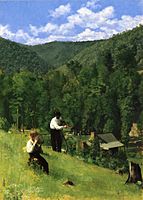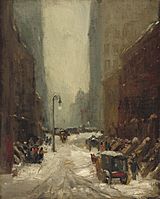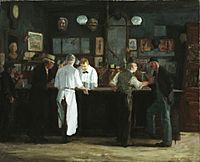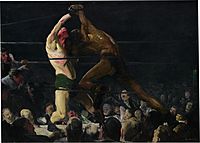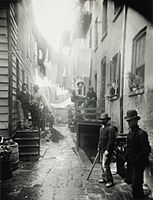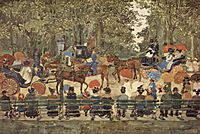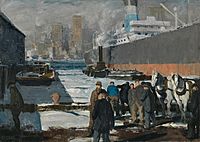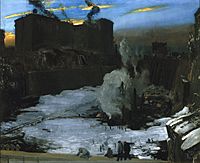Ashcan School facts for kids
The Ashcan School was an artistic movement in the United States during the late 1800s and early 1900s. These artists are best known for painting scenes of daily life in New York City, often showing the city's busy streets and neighborhoods.
The most famous artists in this style included Robert Henri (1865–1929), George Luks (1867–1933), William Glackens (1870–1938), John Sloan (1871–1951), and Everett Shinn (1876–1953). Some of them studied art together. Others met while working as illustrators for newspapers in Philadelphia. Theresa Bernstein was also part of the Ashcan School. She was friends with many of its well-known members.
The movement was inspired by the poet Walt Whitman. Many people saw it as a symbol of the rebellious spirit of that time.
Contents
What Was the Ashcan School?
The Ashcan School was not a formal group with strict rules. The artists did not write down their goals or see themselves as a single team. Some artists were interested in politics, while others were not.
Their main goal was to show the truth about city life and modern times. They felt that other artists ignored these real-life scenes. Robert Henri was a key figure for this group. He believed art should be like journalism, showing things as they truly were. He encouraged his students to paint the everyday world in America. He wanted them to be brave and not worry about what people thought. He felt that working-class and middle-class city settings offered better subjects than fancy drawing rooms.
Where Did the Name "Ashcan School" Come From?
The name "Ashcan School" was a bit of a joke. It came from a complaint in a magazine called The Masses. The complaint said there were too many "pictures of ashcans and girls hitching up their skirts." This comment was made after the artists had been working together for about eight years. They found the name funny, and it stuck.
These artists were also sometimes called "The Apostles of Ugliness." The term "Ashcan School" was first used to make fun of them. This group is known more for what they painted than for new painting techniques. They often showed street kids and city scenes. Their work is similar to that of photographers like Jacob Riis and Lewis Hine, who documented city life. Many Ashcan painters used to work for newspapers. They drew pictures for news stories before photography became common.
Robert Henri returned from Paris in the mid-1890s. He was not impressed by the art he saw there. He wanted to create art that connected with real life. He shared this passion with other artists. The group was even called "the revolutionary black gang" because they often used dark colors. Their first big exhibition in 1908 was a success.
Why Was Their Art Different?
Many famous Ashcan works were painted in the early 1900s. At the same time, writers like Stephen Crane were writing realistic stories. Journalists were also highlighting poor living conditions in cities. The term "ash can art" was first used by artist Art Young in 1916. By then, it included many painters beyond the original group. This included artists like George Bellows and Edward Hopper. However, Hopper did not like the label.
The Ashcan School artists went against the popular art styles of their time. These styles included American Impressionism and academic realism. These older styles were often very polished and showed perfect scenes. In contrast, Ashcan works were usually darker and painted more roughly. They showed the tougher parts of modern life.
They painted street kids, animals, subways, crowded buildings, and lively theaters. They also painted boxers and wrestlers. Their focus on poverty and the real side of city life made some critics uncomfortable.
The End of an Era
When modern art became popular in the United States, the Ashcan School's rebellious image faded. After the Armory Show in 1913, new art styles like Cubism and Expressionism became popular. Henri and his group started to seem less radical to younger artists. Their rebellion ended not long after it began. By 1920, many people saw their art as old-fashioned.
Connection to "The Eight"
The Ashcan School is sometimes linked to a group called "The Eight." However, only five members of "The Eight" were Ashcan artists. These were Henri, Sloan, Glackens, Luks, and Shinn. The other three artists painted in very different styles.
"The Eight" had a well-known exhibition in 1908. This show brought Ashcan art to more people. It helped them get more attention and sell more paintings.
The exhibition at the Macbeth Galleries in New York was a protest. It challenged the strict rules of the National Academy of Design. The artists wanted more chances to show new and different art. After New York, the exhibition traveled to many other cities. Reviews were mixed, but many people were interested. This showed that people across the United States were open to new kinds of art. Sales and exhibition chances for these painters grew a lot in the years that followed.
Gallery
-
Ashcan School artists, c. 1896, left to right, Everett Shinn, Robert Henri, John French Sloan
-
Robert Henri, Snow in New York, 1902, National Gallery of Art, Washington, DC
-
George Luks, Street Scene, 1905, Brooklyn Museum
-
Everett Shinn, Cross Streets of New York, 1899, Corcoran Gallery of Art, Washington, DC.
-
William Glackens, Italo-American Celebration, Washington Square, 1912, Boston Museum of Fine Arts
-
John French Sloan, McSorley's Bar, 1912, Detroit Institute of Arts
-
George Luks, Houston Street, 1917, oil on canvas, Saint Louis Art Museum
-
George Bellows, Cliff Dwellers, 1913, oil on canvas. Los Angeles County Museum of Art
-
George Bellows, Both Members of This Club, 1909, National Gallery of Art. Bellows was a close associate of the Ashcan school.
-
Jacob Riis, Bandit's Roost, 1888, (photo), a part of New York City.
-
Arthur B. Davies, Elysian Fields, oil on canvas, The Phillips Collection Washington, DC.
-
Maurice Prendergast, Central Park, New York, 1901, Whitney Museum of American Art
-
George Bellows, Men of the Docks, 1912, National Gallery, London
-
Pennsylvania Station Excavation by George Bellows, c. 1907–08, Brooklyn Museum
-
Edward Hopper, New York Interior, c. 1921, Whitney Museum of American Art
See also
 In Spanish: Escuela Ashcan para niños
In Spanish: Escuela Ashcan para niños


